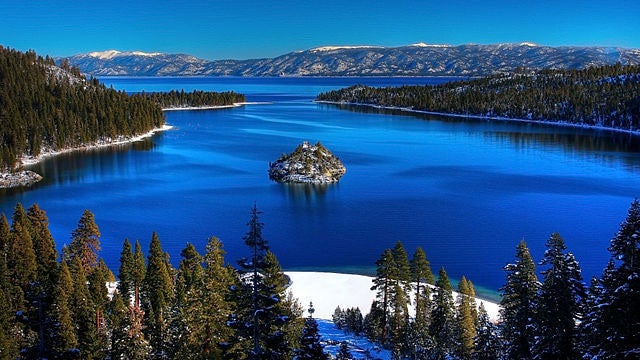Lake Tahoe is the clearest lake of its size in the United States and one of the deepest, but development around the lake has greatly diminished its clarity. In 1968, one could see an astounding 97 feet down from the lake’s surface. Now, it’s 75 feet—on a good day.
Clarity is important not just because the blue waters of Lake Tahoe help stoke a bustling year-round tourism industry. Clarity is in fact a key to a healthy ecosystem in the lake, says Geoffrey Schladow, who directs the Tahoe Environmental Research Center and is a professor of Water Resources and Environmental Engineering at the University of California, Davis.
“Under clear conditions, we get a lot of penetration of UV radiation” deep into the lake, he says. “It probably has some of the highest UV penetration of any lake in world.” Losing that UV penetration has opened the door for invasive species, such as large mouth bass, bluegills and carp. “When these invasives reproduce, their young can’t stand that UV radiation and they die. But native fish are adapted to it,” he explains.
The loss of clarity in recent decades is due to sediment runoff, which is a byproduct of building and development around the lakeshore, as well as car and truck emissions. This runoff, combined with accidental introductions of invasive species, which can hitchhike a ride into the lake via boats, have significantly altered the lake’s ecosystem. The lake temperature is also rising, most likely due to climate change. Schladow and the research center are part of large, coordinated effort to improve Lake Tahoe’s clarity and restore its natural habitat.
That is the subject of a short documentary called “Lake Tahoe: Can We Save It?” produced by , a collaboration between six Public Broadcasting stations around the country. The show premieres October 16, but we’ve embedded it below so you can watch it now (thanks, QUEST!).
We’ve known for decades that sediment runoff is hurting lake clarity and initial steps to combat it date back to 1987, in a plan designed by the Tahoe Regional Development Agency, created in 1969 through a compact between California and Nevada. Property owners around the lake have installed sediment traps, which have lead to better clarity during the wet winter months, but the lake’s summertime clarity continues to fall, and Schladow does not know why. “Really, everything is on the table,” he says. “We’re looking at climate change, the impact of invasive species … There is something there that is causing the lake to change in a negative way.”
As reported in January, the Tahoe Regional Development Agency has created a new development plan that will attempt to further mitigate environmental harm to the lake, while also appeasing business interests to grow the infrastructure and services around the lake. The plan nearly fell apart, however, when Nevada threatened to drop out of its long-standing compact with California (1/3 of the lakeshore is in Nevada), but the two States have now settled their differences.
That said, the waters are still far from tranquil. This winter, the Tahoe Regional Sierra Club filed a lawsuit, seeking to stop the new development plan in its tracks. The group claims the new plan does not go far enough to protect the lake, and it cedes too much to developers’ interests.
Not all environmental groups that work to protect the Sierras are on board with the Sierra Club, however. The League to Save Lake Tahoe approves of the new development plan, and recently that although it’s not a perfect approach, it will allow developers to rehab and make more ecologically sound many structures that have been languishing since the 1987 development plan.
Schladow says the Sierra Club suit is doing more harm than good. “I think [it is] hampering progress,” he says. “If the suit is successful, then suddenly we’re back in the possibility that Nevada will withdraw and there will be no compact. Suddenly, two States will be trying to regulate one lake. Would Nevada sue California (over disagreements)? Would California sue Nevada? That would be unworkable.”


